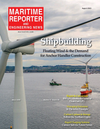
Page 14: of Maritime Reporter Magazine (August 2023)
Shipyard Annual
Read this page in Pdf, Flash or Html5 edition of August 2023 Maritime Reporter Magazine
Eye on Design
An Honest Discussion About AI
By Kyle E. Marlantes he maritime industry is often criticized as largely what contributes to their appeal: a model can be being slow to adopt new technologies. trained to ? t virtually any type of data. Sometimes
While ship building is an age-old this property is referred to as universal approxima-
Tindustry, it is also varied: ? shing, tion, but this doesn’t mean the model can predict commercial, inland, marine construction, every possible outcome. In fact, a well-trained energy, passenger, recreation, defense, and model can only make reliable predictions with- the list goes on. Each sector serves a dif- in the con? nes of its training dataset. In col- ferent purpose, and bespoke vessels ful? ll loquial terms, the resulting AI thinks inside the different missions, operate in different envi- box. If only one fact should be understood by ronments, and are subject to different regula- prospective industrial users of AI, it is that AI— tory pro? les. As a result, our industry abounds in its current form—cannot synthesize information with unique solutions, but often it is not the kind of that is beyond its original training dataset. There are innovation that ? ts in your pocket. some who will surely challenge this statement, but for the
Perhaps the criticism comes from the fact that ship build- time being, true synthesis remains a distinctly human ability. ing, and the industry it serves, is a highly competitive and When it comes to deploying AI, data is paramount. Because dynamic market, and this may reward strategic and measured the capability of AI is limited by the data to which it has ac- investment. Our industry is not averse to technology, but per- cess, this means two things: haps we are pragmatic in our choices. Unlike some consumer 1) to derive value from AI, you need a robust data set, and products, if the industrial adoption of technology is not for 2) if the relationships within the data are complex, you will the sake of novelty, a strong value proposition is a prerequi- likely need a lot of data. site for wide acceptance. These two facts make applications where data is plentiful,
This sort of pragmatism seems to ? y in the face of the and patterns identi? able, yet conventional modeling is dif- social-media-fueled juggernaut that is Arti? cial Intelligence ? cult, easy candidates to derive value from AI. Most of the (AI). Have you heard? The promises are grand and the pre- applications of AI which we see in our news and social feeds monitions ominous. Sadly, dialogue of this type misses the tackle problems in this category. mark when it comes to exploring the possible value of AI In the maritime industry, there are similar data-rich use cas- from an industrial perspective. Yet this does not diminish es which can bene? t from AI. This includes equipment moni- the importance of the question: what value does AI offer the toring, health, and failure detection, operational and voyage maritime industry? planning, fuel, and energy monitoring—areas already seeing
To answer this question, it helps to know a little about the successful commercial deployment of the technology. Ship- digital machinery that makes AI possible. Let’s look at what yard operations also create a lot of data related to work? ow, goes on under the hood: machine learning (ML). Machine material moving, and inventory, and if the data were acces- learning models are con? gurable computer algorithms which sible, AI could help identify and leverage unseen patterns and can learn complex relationships within data. The models have relationships. AI is extremely valuable when it can expose re- tens, hundreds, thousands, or even millions of tunable param- lationships within available data that we didn’t know existed, eters, and they learn by optimizing the parameters to conform or were unable to model in other ways, and many of the cur- to a data set in a high-dimensional, nonlinear, and sometimes rent industrial applications of AI leverage this fact as part of eerily intelligent way. There are many different types of their value proposition.
models, but the details and differences between each are not However, there are many problems in the maritime indus- important in this discussion. The most important concept to try which are not data rich. This is often due to the nature of remember is that ML models are trained to map inputs to out- the problem, for example, improbable events are dif? cult to puts—even if the relationship between them is not obvious. learn due to their infrequent occurrence. But it may be that
The adaptable and con? gurable nature of ML models is the necessary data are simply too dif? cult—or expensive—to 14 Maritime Reporter & Engineering News • August 2023
MR #8 (1-17).indd 14 8/3/2023 1:10:33 PM

 13
13

 15
15
